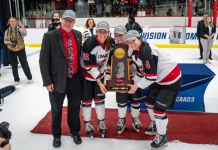
Editor’s note: At the time of publishing, NCAA quarterfinals were still scheduled to be played and teams were en route to the host universities.
Sunday was a historic day in women’s DI hockey as both Ohio State and Princeton won their first-ever conference tournament titles.
In the WCHA, Wisconsin, Minnesota and UMD had won all the conference’s championships, with the Badgers and Gophers holding serve for the past ten years.
Ohio State winning the WCHA tournament was only a matter of time, according to Wisconsin coach Mark Johnson.
“Especially in the last six or seven years, our league from top to bottom has gotten stronger, it’s gotten deeper, and it was just a matter of time for somebody coming in here and winning our playoffs. The next step is going to be somebody winning our league. You follow Ohio State the last couple of years, and they’re right there. They were in the Frozen Four already. Last year we scored a goal late in the game to beat them in the semifinal game here. They’re close, and now they’ve taken the next step,” he said.
The win was even more impressive for Princeton, who had never made an ECAC championship before despite having fielded a women’s hockey team since 1984. Tiger coach Cara Morey wasn’t even aware that her program had never been to the championship game.
The Tigers went down 2-0 early in the championship game, but they were coming off a weekend where they played three overtimes against Quinnipiac in two days. The team was battle tested and the series built grit, Morey said.
The one bonus of trailing early was that Morey was able to tell her team to relax and reset because there was still a lot of hockey left. There wasn’t a lot of pressure on them. Cornell was the favorite and they were up. Princeton had nothing to lose and they chipped away. They played loose and most importantly, Morey said, her team was having fun. That, she thinks, was what ultimately helped them win.
“It was amazing for Princeton. We’ve really been working hard to make Princeton a hockey place, for people to look at us as a legitimate program. It’s an awesome opportunity. We’ve been building to this for a few years. I think that we’re putting Princeton hockey on the map. It’s amazing to see it coming to fruition,” said Morey
First-time champions aren’t necessarily a sign of a changing of the guard so much as a sharing of the top steps. These teams winning doesn’t change that their conferences have other powerhouse programs, nor does it signal that those programs are in decline. But it does show how much parity the women’s game has now. It’s good for the game to have more teams that can consistently compete to be the best in the country.
Wisconsin coach Mark Johnson has been coaching Division I women’s hockey for 18 seasons. He’s seen the game grow from it’s NCAA origins and he’s been a vocal supporter of bringing the college game to areas that wouldn’t normally experience it as well as scheduling new programs to fill their roster and help them get exposure.
“When I first started, the whole premise was to try to help other programs get better and stronger and make our league very competitive. From a coaching standpoint, you always want to win. But in the bigger picture, to grow girls’ hockey and women’s hockey, not only around our locations and our universities, but within our states and around the country. It’s better to have competitive games. It’s better to have teams build their programs and become competitive,” he said.
Buckeye junior Tatum Skaggs, who scored the overtime game-winner in the semifinal and the final summed it up succinctly.
“Finally,” she said.
Finally, she felt, all the hard work had paid off. After coming close in recent years, Ohio State has the validation of a trophy.
“We are getting our school on the map.”
Skaggs is part of a group of players that came to the program at the same time coach Nadine Muzerall took over the program. Skaggs said Muzerall turned the Buckeyes around. Muzerall had never been a head coach before, but her tough, no nonsense style has proved to be the perfect match for the program and players at Ohio State.
“I came in and (Ohio State) gave me a chance. Same with these girls. They wanted to join a program (and) wanted to make a difference. They didn’t want to just be another number on another team,” she said. “(This win) was nothing but everybody giving all that they had. We’d never been on this stage before and we talked about making history. That was motivation.”
Though having more tough teams makes life harder for the programs that have historically been on top, Johnson said it’s what is best for the future and growth of the women’s game.
“(In) the overall landscape of women’s hockey, this is what we need. It makes our jobs (as coaches) harder and more competitive, but that’s what we sign up for, and I’d rather see games go into overtime and close-knit games, and people getting those opportunities to get those experiences as players,” he said.
Though it was secondary to her team’s win, Morey also noted how special it was that she and Muzerall both rewrote history on International Women’s Day.
“These players that are going to be our future leaders have these strong female role models,” Morey said.


